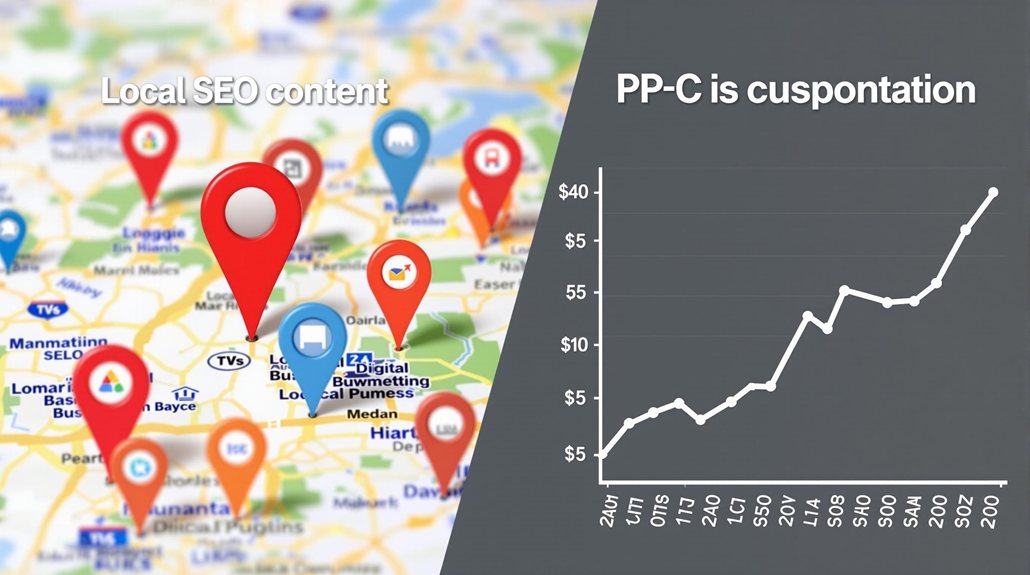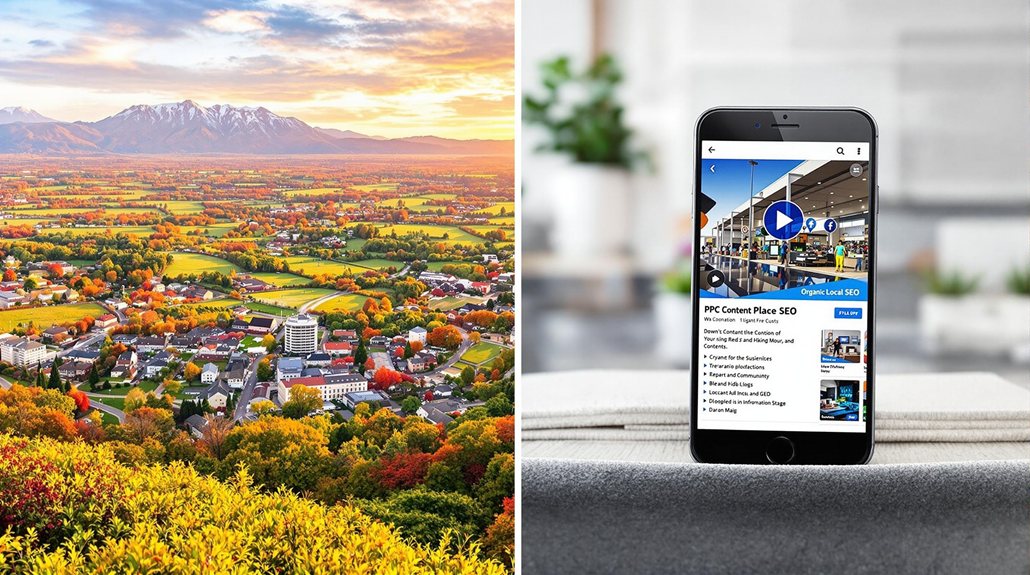Local SEO and PPC content differ in their approaches. Local SEO builds long-term credibility and organic visibility, while PPC provides quick, targeted visibility and immediate conversions. Local SEO requires initial investment but yields sustainable results, whereas PPC has ongoing ad costs. Leveraging the strengths of both can create a powerful digital marketing strategy. If you'd like to explore the nuances further, the following sections dive deeper into the key differences and how to combine them effectively.
Cost Comparison

Though the costs of local SEO and PPC can vary significantly, you'll generally find that local SEO is more cost-effective in the long run. Local SEO services range from $100 to $2,000 per month for small businesses, while comprehensive services can reach $4,000. Businesses typically allocate 6% – 15% of their total marketing budget to local SEO. In contrast, PPC pricing fluctuates based on ad spends and campaign complexity. While PPC offers quicker visibility, it also incurs direct click costs. Conversely, SEO requires initial investments but yields sustainable results over time. Additionally, local SEO's cost-effectiveness improves as rankings stabilize. Ultimately, the optimal strategy depends on your long-term goals and industry competitiveness.
Credibility and Authority Building

Building credibility and authority is crucial for local SEO success. Quality content, positive reviews, and consistent NAP listings across platforms help establish your business as a trusted local authority. Engaging with local bloggers and news sites for backlinks further boosts your credibility. Maintaining an active social media presence also fosters trust and local credibility. In contrast, PPC ads may provide quick visibility, but they lack the long-term authority-building benefits of SEO. Targeting problem-aware keywords and ad positioning don't necessarily equate to credibility. To build lasting authority, focus on optimizing your Google Business Profile, earning map pack listings, and generating relevant local content and customer feedback.
Organic Visibility and Traffic Acquisition

Organic SEO allows you to build lasting visibility and attract targeted traffic through optimized content and design. Unlike PPC, this approach requires consistent effort but offers cost-effective, long-term results. By understanding the nuances of organic search mechanics, you can develop a sustainable traffic acquisition strategy tailored to your business goals. Local mobile searches are growing 50% faster than overall mobile searches, which highlights the importance of optimizing for local visibility.
Organic Search Visibility
Organic search visibility is a critical component of a robust digital marketing strategy. It drives over 50% of website traffic, with users placing greater trust in organic results compared to paid ads. Ranking well in search engines can provide a significant competitive advantage, as the top organic result enjoys a click-through rate of nearly 28%. Moreover, moving up just one position can increase CTR by around 3%. 46% of all Google searches are local searches, which highlights the importance of optimizing for local SEO. To maximize the impact of organic search, focus on creating relevant content, adhering to Google's guidelines, and building high-quality backlinks. Organic search visibility is a long-term investment, but the benefits of increased brand awareness, user engagement, and conversion potential make it a worthwhile endeavor.
| Organic Search Visibility Metrics | ||||
|---|---|---|---|---|
| Organic Traffic Share | CTR Benchmarks | User Engagement | Brand Awareness | Conversion Potential |
Targeted Traffic Acquisition
Targeted traffic acquisition is the cornerstone of any effective digital marketing strategy. You can focus on organic search engine optimization (SEO) to drive free, long-term traffic or leverage paid search engine marketing (PPC) for immediate, targeted results. SEO emphasizes keyword-optimized content and authority-building backlinks, while PPC allows you to precisely target audiences based on demographics, interests, and behaviors. Each approach has its strengths – SEO offers higher click-through rates, while PPC provides faster returns. The most successful strategies integrate both SEO and PPC, using data insights to refine content and ad campaigns. Carefully tracking key metrics like conversion rates, engagement, and ROI helps you maximize the effectiveness of your targeted traffic acquisition efforts.
Long-Term Sustainability
While organic visibility and traffic acquisition are essential for long-term sustainability, local SEO offers a strategic approach to achieving these goals. Unlike PPC, which provides quick visibility but incurs immediate costs, local SEO fosters gradual yet compounding ROI through enhanced brand awareness and niche authority building. By emphasizing consistent, engaging content and leveraging relevant local keywords, local SEO ensures adaptability to algorithm updates, securing your online presence over time. Local SEO also helps businesses maintain a strong local online presence over time.]
To maximize the long-term impact of local SEO, consider these data-driven strategies:
- Integrate analytics to inform real-time performance optimization.
- Regularly update and optimize content to align with Google's evolving guidelines.
- Identify and address content gaps using long-tail keywords.
- Synergize local SEO with other marketing channels for a holistic digital strategy.
Immediate Results and Conversion Potential
When it comes to immediate results, local SEO and PPC content offer distinct advantages. Local SEO can provide quick visibility through Google Business Profiles, location-specific content, and real-time updates. This can lead to a purchase within 24 hours for 28% of local searches. PPC, on the other hand, offers instant visibility at the top of search results, targeted traffic, and immediate clicks – ideal for users with an urgent need. Nearly 25% of website traffic comes from local searches, which highlights the immediate relevance of local SEO.
In terms of conversion potential, local SEO excels with 78% of mobile local searches resulting in offline purchases. PPC also shines, with a return on ad spend of up to $8 for every $1 spent. Both tactics leverage intent, reputation, and mobile to drive high-converting traffic.
Sustaining Long-Term Traffic Streams
Although local SEO takes time to build traffic, the long-term benefits are significant. Unlike PPC, which requires constant spending, local SEO provides cost-effective, gradual growth through consistent optimization. This approach establishes niche authority, boosts organic engagement, and ensures consistent visibility in search results.
The key to sustaining long-term traffic streams lies in:
- Creating relevant, localized content that aligns with the latest SEO updates.
- Earning backlinks from trusted local sources to enhance credibility.
- Maintaining accurate and updated business listings across platforms.
- Leveraging positive reviews to build social proof and customer trust.
Optimizing for conversational keywords enhances local search visibility and appearance in voice search results.
Geographical and Keyword Targeting
Geographical and keyword targeting are two distinct yet complementary strategies that play a crucial role in both local SEO and PPC. In local SEO, geo-targeting leverages location-specific keywords to enhance visibility, while optimizing business listings in local directories. Accuracy is key, often relying on Google My Business. For PPC, geo-targeting allows for precise ad delivery based on user location, providing quick results. Keyword targeting, on the other hand, involves optimizing content and ad copy to match user search queries. Both methods enhance relevance and engagement with local audiences, though local SEO offers long-term, gradual results, while PPC delivers immediate impact. Successful local marketing campaigns integrate both strategies effectively.
Demographic and Behavioral Targeting
Demographic and behavioral targeting play a pivotal role in both local SEO and PPC strategies. Advertisers leverage age, gender, and income data to optimize content and ads. Meanwhile, understanding user intent and purchase behavior refines marketing approaches. Relevance: Tailoring messaging based on demographic information provides personalized and relevant content for consumers. Consider these key differences:
- Demographic targeting offers broader reach, while behavioral targeting yields more precise results.
- SEO focuses on demographic targeting, whereas PPC provides flexibility in both demographic and behavioral approaches.
- SEO builds long-term brand awareness, while PPC can generate immediate leads.
- Both methods face data privacy concerns and require continuous adaptation to evolving user needs.
Striking the right balance between demographic and behavioral targeting is crucial for local marketers to maximize ROI.
Adjusting Market Strategies
As the market evolves, you'll need to adapt your strategies accordingly. Responsive marketing allows you to quickly adjust your PPC campaigns to align with new opportunities or trends. Maintaining relevance in local SEO also requires regularly updating your content to stay ahead of algorithm changes.
Adapting to Market Shifts
Adapting to market shifts requires flexible marketing strategies. Whether it's algorithm updates affecting local SEO or fluctuating cost-per-click (CPC) impacting PPC, staying ahead of the curve is crucial.
Consider these 4 ways to adapt:
- Conduct regular keyword research to identify local search trends and adjust content accordingly.
- Optimize PPC ad copy based on consumer feedback and market shifts to resonate better with the target audience.
- Leverage specialized local SEO tools to monitor and adjust strategies in response to market changes.
- Continuously test PPC ad variations and reallocate budgets to maximize ROI.
Responsive Marketing Strategies
To stay ahead of the curve, you'll need to employ responsive marketing strategies that enable quick adjustments to your tactics. Real-time data integration, current events integration, personalization, and an omni-channel approach are crucial. Analyze consumer sentiment, distribute timely content, and enhance engagement to build trust and relevance. Responsive marketing can be seen in examples like Ikea's Game of Thrones campaign and Oreo's Super Bowl ad.
| Responsive Marketing Strategies | Benefits |
|---|---|
| Real-Time Data Integration | Agility to adjust tactics quickly |
| Current Events Integration | Maintaining relevance and topicality |
| Personalization | Enhancing consumer engagement |
| Omni-Channel Approach | Distributing timely content across platforms |
Leverage marketing automation, retargeting, and data analysis tools to execute responsive strategies effectively.
Content Relevance for Local Search
Content relevance is crucial for local search, as it directly impacts search engine rankings and user engagement. Local SEO content should be tailored to meet local intent, often focusing on specific geographic areas or services. By utilizing local keywords and creating content around local events or news, you can improve relevance. Additionally, claiming and optimizing profiles on local listing sites, such as Google My Business, helps maintain consistency and relevance across directories.
Here are 4 key ways to enhance content relevance for local search:
- Prioritize location-specific content to cater to local intent.
- Leverage local keywords and events to increase relevance.
- Optimize local business profiles for consistent information.
- Regularly update content to reflect evolving local trends.
Precise Audience Targeting
While local SEO automatically targets users searching for services in specific geographic areas, it offers less granular control over demographic or behavioral targeting compared to PPC. Unlike PPC, which allows precise targeting based on location, device, and user behavior, local SEO relies more on intent-based targeting. However, this natural audience segmentation ensures your content reaches users actively seeking local services. Conversely, PPC's advanced targeting options enable you to tailor your campaigns to specific audience segments, enhancing the likelihood of conversions. Ultimately, the targeting accuracy of local SEO and PPC complement each other, with the former offering long-term organic visibility and the latter providing immediate, data-driven results.
Branding and Authority Development
When it comes to building your local brand identity, local SEO is the way to go. It helps you establish your niche expertise by appearing consistently in local search results, showcasing your authority and credibility. Leveraging local SEO strategies ensures sustained online visibility and a stronger connection with your community.
Building Local Brand Identity
Building a strong local brand identity is crucial for businesses aiming to establish a meaningful connection with their community. From defining core values to creating a cohesive visual identity, there are several key steps.
- Craft a unique value proposition that sets you apart from competitors.
- Incorporate local symbols or themes into your visual branding.
- Ensure consistent messaging across all platforms to build recognition and trust.
- Engage with the community through events, partnerships, and social media to cultivate authority.
Establishing Niche Expertise
Establishing authority within your niche is a crucial step in building a strong online presence. Crafting high-quality, authoritative content is essential, so ensure your keyword research aligns with relevant topics and queries. Collaborating with industry influencers enhances your credibility, while engaging with your audience fosters trust and loyalty. Regularly updating and optimizing your content improves its relevance and search rankings. Leveraging these strategies will demonstrate your expertise, leading to better rankings, increased user trust, and market differentiation. Moreover, building topical authority through content clusters and semantic SEO can further cement your position as a thought leader in your field.
Sustained Online Visibility
Sustaining your online visibility is key to cultivating a strong brand presence and establishing authority in your industry. SEO builds this long-term presence through organic search results, reducing ongoing costs once initial optimization is achieved. Additionally, organic rankings enhance user trust and credibility, providing a competitive advantage when combined with PPC. This consistent traffic supports your branding efforts, while PPC campaigns offer immediate awareness for time-sensitive promotions.
Here are 4 ways to leverage SEO and PPC for sustained online visibility:
- Combine SEO and PPC to dominate search results and increase credibility.
- Use PPC to reach beyond search engines and target users across platforms.
- Ensure consistent messaging across SEO and PPC content to reinforce brand authority.
- Regularly update content to maintain SEO relevance and ongoing authority building.
Promotions and Short-Term Goals
When it comes to promotions and short-term goals, the differences between local SEO and PPC become even more pronounced. PPC can provide immediate visibility and quick sales, making it ideal for promotions requiring fast results. In contrast, local SEO demands more time for implementation and optimization, but supports long-term growth. PPC's success is measured through conversions, while local SEO's is gauged by increased visibility and organic traffic over time. PPC requires a budget for ad spend, whereas local SEO demands expertise and continuous effort. Ultimately, PPC offers an immediate competitive advantage, while local SEO builds authority over time.
Leveraging PPC Insights for SEO Content
Optimize your SEO content by leveraging insights from your PPC campaigns. Analyze the performance of your PPC keywords, ad copy, and user engagement metrics to identify high-performing content that can boost your organic search rankings. Integrate your SEO and PPC strategies to create a unified approach and gain a competitive edge in the search results.
Leverage PPC Keyword Insights
How can you leverage PPC keyword insights to enhance your local SEO content strategy? PPC campaigns provide a wealth of data that can directly inform your local SEO content. By tapping into this valuable intel, you can:
- Identify high-performing, long-tail keywords with strong intent and low competition, perfect for local SEO optimization.
- Uncover user intent signals to create content that aligns with search expectations, boosting engagement.
- Analyze competitor strengths and weaknesses, guiding your local SEO tactics to gain a competitive edge.
- Pinpoint content gaps, enabling you to fill those voids with targeted, relevant local SEO content.
Leveraging PPC keyword insights can elevate your local SEO content strategy, driving greater visibility and performance.
Optimize Content via PPC Data
By leveraging data from your pay-per-click (PPC) campaigns, you can optimize your search engine optimization (SEO) content strategy and enhance its overall performance. Use PPC ad copy to refine meta descriptions and improve click-through rates. Test ad copy variations and apply successful elements to your SEO content. Analyze PPC landing page data to identify user experience issues and fill content gaps. Geo-targeting insights from PPC can enhance local SEO by creating more relevant content. Continuously monitor PPC campaign performance to refine your SEO content strategy and ensure it aligns with user preferences.
Integrate SEO-PPC Strategies
Integrating your search engine optimization (SEO) and pay-per-click (PPC) strategies can provide a significant boost to your digital marketing efforts. By leveraging the insights from your PPC campaigns, you can refine your SEO content strategy and improve overall performance. Consider these key benefits:
- Competitive Insights: PPC data offers valuable information on your competitors' strategies, which can inform your SEO decisions.
- Keyword Performance Data: PPC insights help identify high-converting keywords, allowing you to optimize your SEO content.
- Faster Feedback Loops: PPC provides immediate results, enabling you to quickly adjust and improve your SEO tactics.
- Audience Building: Organic traffic from SEO can be utilized to build targeted PPC audiences, enhancing your customer engagement.
Optimizing SEO Content Based on PPC Performance
When optimizing SEO content based on PPC performance, you can leverage the immediate insights from your paid campaigns to enhance your organic search visibility. By analyzing PPC keyword data, you can identify high-performing keywords to prioritize in your SEO strategy, ensuring your content aligns with customer intent. Utilize PPC ad copy and landing page insights to craft more engaging SEO content that resonates with users. Testing different elements in your PPC ads can also inform SEO content optimizations, such as fine-tuning meta descriptions. Ultimately, marrying your PPC and SEO efforts allows you to create content that is both relevant and compelling, boosting your overall search presence.
Comprehensive Digital Marketing Presence
Establishing a comprehensive digital marketing presence is crucial for businesses seeking to thrive in today's competitive landscape. By strategically integrating local SEO and PPC, you can create a robust online presence, enhancing both organic and paid visibility. Consider these key factors:
- Cost-Effectiveness: Local SEO is generally more cost-effective than PPC, providing long-term visibility without ongoing costs.
- Immediate Impact: PPC offers immediate traffic and exposure, which is vital for promotional campaigns.
- Sustainable Growth: Local SEO supports sustainable business growth through repeated customer visits.
- Targeted Advertising: PPC allows precise targeting of demographics, behaviors, and locations, complementing the reach of local SEO.
